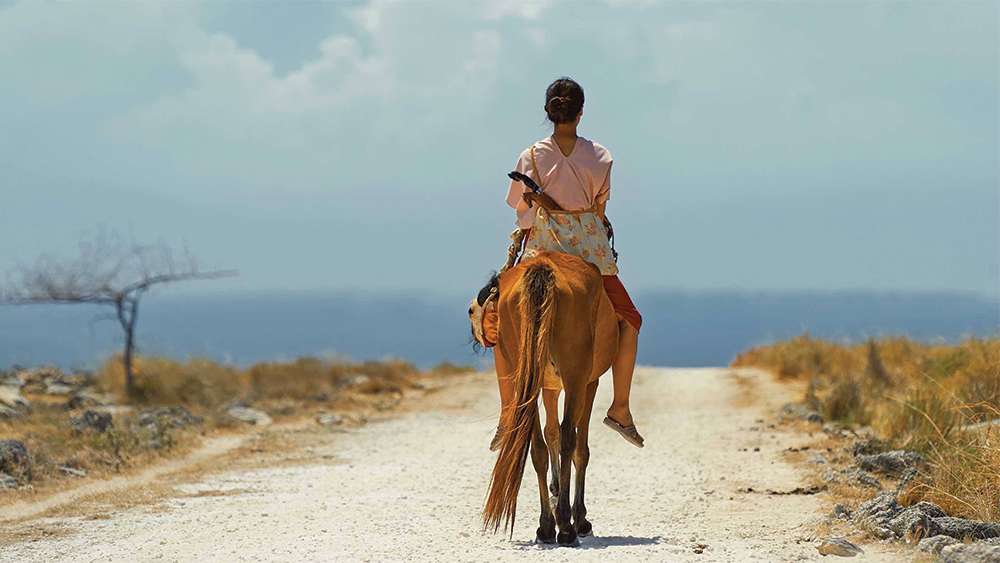“Women & Horror” is a four-part series of features on horror films directed by women.
Content warning: This article discusses major plot details, which includes mentions of sexual assault and descriptions of violence.
Marlina the Murderer in Four Acts is at first glance a convergence of cinematic influences. Set in a rural Indonesian town, the story follows the recently-widowed Marlina’s (Marsha Timothy) journey after she murders a band of thieves and rapists in self-defense when they invade her home. The film, with its simplistic narrative divided neatly into four acts, is less about the moral gaze and more about its visual and aural rhetoric, recalling the works of Sergio Leone and others that make up the “spaghetti western” genre. Director Mouly Surya also utilizes the conventions belonging to Asian art cinema, and her infusion of the two styles makes Marlina the Murderer into an affecting work of the revisionist rape-revenge genre. The film uses a mix of western and Asian art cinema conventions to undermine questions of morality, as well as position its female protagonist and a female side character as victim-avenger heroines through visual and aural means.
The connections between the western and rape-revenge genres have been explored for decades. Films, like Clint Eastwood’s Unforgiven, are often cited as a revisionist Western texts for how they question the moral order of the genre through its use of iconic Western images and conflation of violence and corruption. From the establishing shot to its very last frame, Marlina the Murderer is doused in iconic western imagery, and like Unforgiven, the film uses it to thematically explore dark topics, such as the power dynamic between men and women in a poor, rural society.
In the beginning of the film when Markus (Egy Fedly) arrives to Marlina’s home, sits down uninvited on her floor, and plays a musical string instrument, the association between the lawlessness of the western genre and Markus, Marlina’s rapist and the leader of thieves and rapists, is set. The music Markus repeatedly plucks into the air falls right into the film’s score, which is reminiscent of Ennio Morricone’s work from Leone’s western films. After Marlina kills Markus and heads out on a journey to the police station with his decapitated head in tow, this same tune follows her in the form of his headless body, still plucking away at its instrument. The ghost of Markus is some of the most explicit evidence that the film provides in regards to Marlina and morality. While the ghost is haunting Marlina, the severity of this consequential haunting is cut down by how darkly humorous it is seeing a headless body casually strumming away on an instrument. It seems like less of a question of Marlina’s feelings of guilt and more of a lesson of how women face more complex and even arbitrary challenges as a result of violence.
While Marlina’s visual and aural haunting may be tied to morality, the framing and composition of her scenes are used to quickly establish her as a victim-avenger protagonist. Noting the conventions that belonged to Asian art cinema, the film’s long, fixed-frame shots showcase the tense exchanges between the characters. These shots assist in positioning Marlina as a victim-avenger protagonist by creating an intimacy between the character and the audience. The audience sees Marlina’s even expression but notices how the rapid movement of her eyes juxtaposes her stillness, providing the audience—and only the audience—a glimpse of her real emotions.
The fixed frame shots allow the audience to establish a familiarity with Marlina from the onset, and this technique is utilized, or mirrored, at the end of the film, when the audience sees Marlina’s pregnant neighbor Novi (Dea Panendra) being held hostage in her house by one of Markus’ surviving lackeys Franz (Yoga Pratama). This mirrored ending with Novi taking a machete to Franz’s head to stop his rape of Marlina—in addition to enacting her own revenge upon him for damaging her husband’s trust in her—sustains the cycle of vengeance, delivering on genre expectations of a violent and deadly climax but also subverting and challenging those expectations by following the deadly blow with the birth of a baby.
The ambiguity and contradictory nature of the final scenes provide ample room to explore Marlina the Murderer in Four Acts as a revisionist rape-revenge text. Blending together varying cinematic stylistic conventions, the film uses fixed frame shots and sound to fortify the relationship between the protagonist and the viewer. The headless Markus strumming his guitar is less shocking as it is darkly funny, blurring moral boundaries. Marlina is clearly presented as a victim-avenger protagonist with how the director frames the character to give the audience intimate access to her face and tiny hints of expression. It is the brutal nature of the film, which indulges in very little gore visually, that makes an interesting statement. The violence in Marlina the Murderer is minimal and contained when compared to other works in the genre, but the violent acts’ overreaching effects are loud and life-changing. Especially for women, it is also after the act where the horror still exists, trailing after them and upending their journey… until they take care it themselves.
Advertisement
Marlina the Murderer in Four Acts is streaming on Prime Video.
Advertisement
